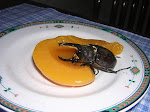 Birding by ear... A lazy way of birding from the sofa or bed,
Birding by ear... A lazy way of birding from the sofa or bed, provided there's an open window. Or more scientifically, an efficient way to identify birds for field studies. For biologists, some habitats are quite nearly impossible to see their birds in. On the tall grass prairies of Missouri, Henslow's and Grasshopper sparrows might -- if you're lucky -- briefly be spotted darting just over the tops of coneflowers before abruptly disappearing back into the hip-high grass. "Streak of something" is about as good as it gets without the advantage of their spring time singing from the safety of the grasses. The same is true for birds in numerous other habitats: the dark forests of the Northeast and Pacific Northwest, deep canyons of the desert Southwest, etc.
Birding by ear was a requirement for several of the temp/seasonal wildlife jobs I had. Once I caught the itch, it became addictive. And it will for you, too. Imagine this: you arrive at the grocery store, and as you walk across the parking lot, you hear two American Robins, a gaggle of early-arriving male Western Tanagers, and a gentle "tseeew, tseeew" from the oft-overlooked Cedar Waxwings atop a deciduous tree...All without EVER taking your eyes off the ground in front of your feet. Birding never was so sweet.
This is the best time of year with the chatter of singing males. Try it! Bird song CDs are often available at your local library. You can alternatively drop $30 and own a good set; I'd recommend Stokes Field Guide to Bird Songs (note: many CD guides are divided into Eastern and Western United States). A non-comprehensive (but free) on-line source for bird songs and descriptions: eNature.com.
For beginners of bird speak:
Songs vs. calls. Males "sing" spring through summer (rarely into winter). Songs are distinctive, typically composed of many syllables/notes, and are the easiest place to start with vocal ID. Calls are given by males and females alike (as well as young) year-round. Calls are often short (less than 3 syllables), and often several exist for each bird species. Calls can quickly get frustrating, so best to focus on songs. Start with the birds in your area; Audubon will find your local chapters, whose websites should have available bird lists.
If you hope to really embrace birding, versus trying to impress your friends (I've never been accused of that), then I'd recommend getting hold of a bird identification guide book (there are numerous), or bookmarking the Cornell Lab of Ornithology's webpage on bird ID. Create a "profile" of each bird, which will make ID fun and the details easy to recall... Become familiar with where the bird likes to hang out, how it feeds, moves, as well as what it looks like. As you listen to its sound on CD, assign it a personality that'll tie it all in for you. Example: in my native Northwest there are three species of chickadee. Here in the Southwest, there are verdins. The two are very similar in niche and attitude. Verdins sing "tea-cher! tea-cher chew!" Like it's any of their business whether the teacher chews or not... Verdins = a desert chickadee.
Good luck!
+reduced.jpg)


No comments:
Post a Comment